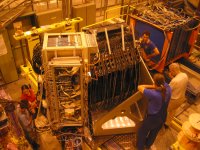 |
 |
|||||||||||||
|
|||||||||||||
|
|||||||||||||
|
This summer, a stage was all the world for some of the men and women of the CALICE collaboration. For the first time, the full prototypes of the electromagnetic calorimeter, the hadronic calorimeter and the tailcatcher and muon tracker (designed and built by international collaborations and assembled in Paris, Hamburg and Northern Illinois respectively) played lead roles in the SPS test beam at CERN. In more than two months, the collaboration collected more than 100 million events, nearly 14 terabytes of data, thus not only testing their prototypes but also the data grid.
In the beginning, it looked like the curtain wouldn't be raised at all for this year's tests. A custom-built movable platform called 'stage' - a massive yellow iron construction that would allow to hold both ECal and HCal and move and rotate them in all possible directions - got severely smashed on the transport from DESY to CERN (see slideshow for some impressions of the damage). Unfortunately it also smashed electronics crates and cables along the way, only leaving the active calorimeter layers and all electronics intact because they were on a different delivery truck. “From outside the container, only a small hole was visible, but after lifting the canvas cover, the devastation inside was shocking,” wrote CALICE HCal project leader Felix Sefkow in an email to his colleagues. “Massive steel parts like the 3-cm driving spindle were bent and burst, so the state of some weaker parts can be imagined. Cable chains were smashed, cables squeezed and cut, power distribution boards crashed, rack and VME crates heavily deformed. The main tool that day was the broom.” After an inventory of all things broken was made, run coordinators Fabrizio Salvatore (Royal Holloway, University of London) and Erika Garutti (DESY) quickly made a new plan to make the best of the precious test beam time. “We spent the first week soldering boards,” says Benjamin Lutz, HCal expert, who stayed at the test beam for the whole summer, seeing only the occasional fireworks for French or Swiss national holidays in-between shifts or being on call. New cables were bought and put in place, new supports and boards set up, much of the destroyed parts were replaced within a week and the team received a lot of help from CERN technicians and crane drivers. An emergency mechanical repair team from DESY was freed of all duties at home and sent on a special mission to fix the stage, hardly stopping to eat or sleep. Now the only visible giveaway that things are not quite as they were planned to be are two yellow straps, tightened around the modules of the HCal. The arms attached to the stage that were supposed to do this job could not be repaired so quickly. On 28 June the first beam went into the three prototypes for the first time. Starting with muon calibration, they collected data with all sorts of beams from 6-GeV electrons to 180-GeV pions and protons and several different angles. A total of 46 members of the CALICE collaboration took shifts around the clock, watching screens, calling the SPS control room, rotating the setup, even calling the CERN fire brigade because of a fire in the beam hall. One important aspect of this year's run (which finished last week) was to rotate the ECal and HCal relative to the direction of the beam. In an ILC detector, particles will rarely enter the calorimeters at a 90-degree angle, so a 80, 70 or 60-degree rotation provides a more realistic situation. So according to a strict time plan, 'shifters' moved the different modules with the help of the repaired stage. The run coordinators are extremely happy with the amount and quality of the data taken during the test beam time. They estimate that they have a 79% efficiency, and this after it looked like there would be no data at all in the beginning. “The data we took in this run should be enough for several diploma and PhD theses,” says Erika Garutti. From data acquisition to comparing the real data with Monte Carlo there will be enough analysis opportunities for current and future members of the collaboration. The main aim of the whole test beam performance is to gain new insights into the physics of hadronic shower development and important guidance for the optimisation of ILC detectors and their reconstruction software. There will be an encore in the form of another test beam, this time at Fermilab, where energies go as low as 1 GeV and different particles can test the modules to the core. The first setup will be identical to the one used at CERN, but after three months the European-built silicon-tungsten ECal will be replaced with the Japanese-built scintillator-tungsten ECal, and a few months later again the scintillator-based HCal will make way for a gaseous digital HCal prototype. This way, all existing CALICE prototypes will have been tested together. All these tests will help the collaboration in the decision which technologies for a future ILC detector are to be or not to be. -- Barbara Warmbein |
|||||||||||||
| © International Linear Collider |

